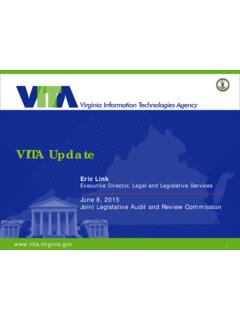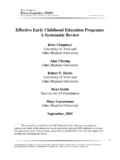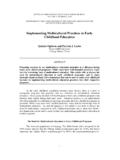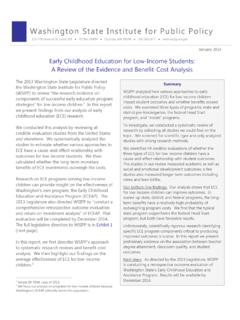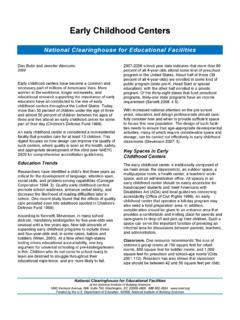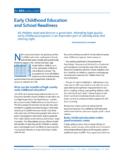Transcription of Improving Virginia’s Early Childhood Development Programs
1 JOINT LEGISLATIVE AUDIT AND REVIEW COMMISSIONC ommonwealth of VirginiaDecember 11, 2017 Improving virginia s Early Childhood Development ProgramsCOMMISSION DRAFTR eport to the Governor and the General Assembly of Virginia2017 JLARC Report 502 2017 Joint Legislative Audit and Review Legislative Audit and Review CommissionChairDelegate Robert D. Orrock, Thomas K. Norment, Terry AustinDelegate Betsy CarrDelegate M. Kirkland CoxSenator Emmett W. Hanger, Janet D. HowellDelegate S. Chris JonesDelegate R. Steven LandesDelegate James P. Massie IIIS enator Ryan T. McDougleDelegate John M.
2 O Bannon III Delegate Kenneth PlumSenator Frank M. Ruff, S. Mavredes, Auditor of Public Accounts, ex officioDirectorHal E. GreerJLARC staff for this reportJustin Brown, Associate DirectorDrew Dickinson, Project LeaderLauren Axselle Sarah Berday-Sacks Maria Garnett Ellie RigsbyInformation graphics: Nathan Skreslet Contents Summary i Recommendations and Options v Chapters 1. Early Childhood Development Programs 1 2. Kindergarten Readiness and Risk Factors 11 3. Voluntary Home Visiting Programs 19 4. virginia Preschool Initiative 31 5. Child Care Subsidy Programs 43 6. Individuals with Disabilities Education Act Programs 53 7.
3 Improving virginia s Early Childhood Development Programs 65 Appendixes A: Study mandate 73 B: Research activities and methods 75 C: Bibliography 85 D: Program inventory 89 E: Core components of effective Early Childhood 92 Development Programs F: Voluntary home visiting Programs : additional details 100 G: Improvements to virginia s Quality Rating and 103 Improvement System H: Individuals with Disabilities Education Act Programs : 106 additional details I: Agency responses 120 Commission draft i Summary: Improving virginia s Early Childhood Development Programs WHAT WE FOUND One-third of all virginia kindergartners may not be fully ready for school Although many of virginia s young children do not need state-supported Early Childhood Development Programs , data indicate that about one-third start school lacking the social, self-regulation, literacy, or math skills needed for kindergarten.
4 Certain factors, such as poverty, low birth weight, and maternal substance abuse, place a child s healthy Development at risk and can strongly influence whether a child is ready for school. The state s information about readiness and children at risk of poor developmental outcomes is not sufficient for identifying children and families at risk and assisting them through the state s Early Childhood Development Programs . virginia s voluntary home visiting Programs are generally effective virginia s seven voluntary home visiting Programs demonstrate effective performance, are generally well designed, and have strong quality assurance mecha-nisms to ensure they are implemented as intended.
5 Par-ticipants often have better outcomes than those who do not participate, both nationwide and in virginia . For ex-ample, participants in virginia s home visiting Programs for pregnant women are more likely than nonpartici-pants to carry their pregnancies to full term, which is associated with positive developmental outcomes. Vir-ginia s voluntary home visiting Programs also feature the key components that experts generally agree are necessary to be effective. However, these Programs lack adequate administrative infrastructure to ensure effec-tive coordination, evaluation, and planning across Programs .
6 The funding for volun-tary home visiting Programs in virginia is unstable and difficult to predict each year, and this instability hinders the ability of the Programs to operate consistently and stra-tegically over time. WHY WE DID THIS STUDY In 2016 the General Assembly directed JLARC to iden-tify and review state-supported Early Childhood devel-opment Programs to determine the best strategy for future Early Childhood investments. ABOUT Early Childhood Development The brain develops most rapidly during the earliest years of a child s life. The Development (or wiring ) that occurs as a result of Early experiences, whether positive or negative, sets the foundation for future success.
7 High-quality Early Childhood Development Programs improve children s odds of success in school and life. However, careful attention is needed to whether pro-grams are well designed, implemented as designed, and perform effectively. virginia has 13 core Early Childhood Development Programs , which include seven voluntary home visiting Programs , the virginia Pre-school Initiative, the Child Care Subsidy Program, and two Individuals with Disabilities Education Act pro-grams. Summary: Improving virginia s Early Childhood Development Programs Commission draft ii VPI improves literacy, but its impact on kindergarten readiness is unknown and program needs stronger assurances of program quality The virginia Preschool Initiative (VPI) improves children s literacy skills, but literacy is recognized as a narrow measure of kindergarten readiness.
8 The state lacks sufficient data to determine whether VPI is effective at Improving other important skills, such as social skills and self-regulation skills, that children need to be ready for kindergarten. There are a number of design and implementation concerns about the VPI program. Implementation of VPI is local, and at the state level, minimal staffing resources are available to administer the program. Further, the program has few features to ensure the program is providing high-quality pre-K experiences statewide. For example, de-spite the critical importance of high-quality teacher-child interactions, VPI has few assurances that they are occurring in VPI classrooms.
9 In addition, the state has minimal effective controls over the quality of the curricula used by VPI providers. Many agency staff and experts expressed concern about the quality of curricula used by providers. JLARC staff identified eight VPI providers that reported using curricula that (1) do not appear to be research-based or (2) are not actual curricula. Currently, the Appropriation Act directs the virginia Department of Education (VDOE) to establish standards for kindergarten readiness and directs school divisions to certify that their VPI Programs follow these standards.
10 The Act does not, though, direct VDOE to take any meaningful actions to monitor or ensure the quality of the program s implementation. VDOE is not required to facilitate individualized profes-sional Development or provide support to Programs most in need of technical assis-tance. Consequently, and in part because of limited staffing resources, VDOE mostly defers to local school divisions to design, implement, and assess their own VPI pro-grams. Ensuring that VPI provides a quality pre-K experience statewide will require VDOE to take a more meaningful role moving forward. Child care subsidy includes few features to promote or incentivize high-quality child care Like many child care Programs nationwide, virginia s Child Care Subsidy Program was initially created to enable parents to maintain employment, obtain an education, or receive training.

